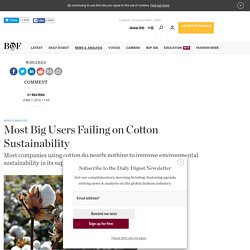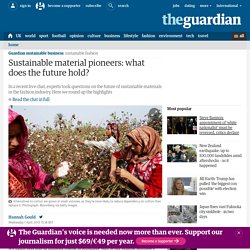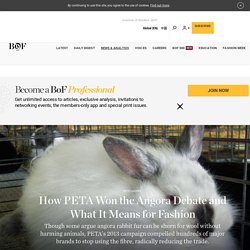

H&M on Conscious Materials. Most Big Users Failing on Cotton Sustainability. STOCKHOLM, Sweden — Most companies using cotton do nearly nothing to improve environmental sustainability in its supply, environmental groups said on Tuesday, citing a report by an online green consumer site.

Traditional farming of cotton, the second-biggest raw material for textile, makes heavy use of pesticides and water. Research by Rank a Brand showed 29 of the estimated 37 biggest cotton users scored red in the survey of policy, sourcing, use and traceability, the report commissioners the World Wildlife Fund, Solidaridad and Pesticide Action network UK said in a joint statement. The world's biggest furniture retailer IKEA was the only company scoring green with 12 of a maximum 19.5 points, followed by apparel retailers H&M and C&A with nine points. The commissioners said around 13 percent of cotton production can be classed as more sustainable, but less than a fifth of it is actually sold as more sustainable. The rest is sold as conventional cotton due to lack of demand. Sustainable material pioneers: what does the future hold? What’s wrong with the materials I’m wearing now?

It’s likely that you’re wearing cotton or polyester, two of the fashion industry’s most popular fibres. Cotton depends on large amounts of water to grow, and polyester depends on now-declining reserves of oil and gas. The idea behind sustainable materials is that they are less damaging to the environment to produce, consuming fewer natural resources and creating less pollution. Erin Smith, artist in residence at Microsoft Research explains: We are living in a time when our growing population and consumption habits are no longer going to be supportable at our present escalating rate. But what would we use instead of cotton? Bamboo, linen, hemp, sisal and even nettles are being looked into as alternatives to cotton, says Susan MacDonald, business development director at CottonConnect.
However, these alternatives are grown in small volumes, so they’re more likely to reduce dependency on cotton than replace it. Protecting Female Workers, Primark on Sustainability, Cotton Recovery. "Low Wages, Unsafe Conditions and Harassment: Fashion Must Do More to Protect Female Workers" (The Guardian) "While approximately 80% of the world’s garment workers are women, the number of women heading the 15 largest mass-market apparel companies on the Fortune 500 list is zero.

" "'I Don't Like Setting Targets' — How Primark Plans to Forge Its Own Path for Ethical and Environmental Change" (Business Green) "According to Lister, the firm's low prices are not achieved through artificially depressing worker's wages and eroding supply chain standards, as some critics allege, but through a combination of volume buying, zero advertising, and tight margins. " "How Cotton Recovery is Changing the Game for Sustainable Fashion" (Triple Pundit) "I:CO has created a closed-loop system in which textiles and shoes can be recycled and remade into new products.
" "Can the Throw-Away Fashion Industry Lead a New Trend Toward Sustainability? " PrettyLittleThing growth continues apace. How PETA Won the Angora Debate and What It Means for Fashion. NEW YORK, United States — In the spring of 2016, a group of top-tier fashion executives convened in midtown Manhattan for a closed-door meeting.

The conversation centred on the treatment of animals and the ethics policies they had in place. It was clear that many brands felt more pressure than ever to cooperate with the People for the Ethical Treatment of Animals — the international non-profit organisation widely known as PETA. “Look at what PETA did to angora,” one executive said. “They virtually wiped it out.” Indeed, in 2013, PETA took on the trade in angora rabbit fur in what proved to be one of its most successful campaigns, releasing a video of a rabbit in China — the world's top producer of angora wool — being tortured and mutilated, its fur hand-plucked from its body. Indeed, sales of angora rabbit wool — not to be confused with the fleece of the angora goat, also known as mohair — have decreased dramatically since PETA launched its campaign.
Related Stories: